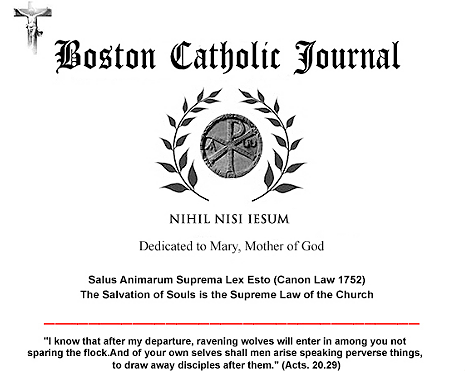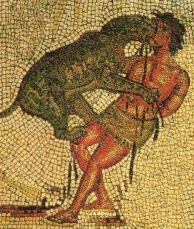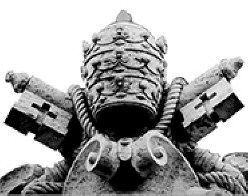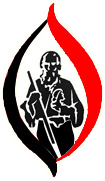|

Mary Immaculate of Lourdes
The Tridentine Latin Mass
and a 2000 year tradition alive
and well in Boston

Mary Immaculate of Lourdes, Newton,
MA
Father Charles J. Higgins,
Pastor
The
Catholic Latin Mass of 2000 years is alive and well in Boston — and
flourishing!
(see the photo gallery!)
Just 15 minutes from down town Boston and just a couple of miles from
route 95 (route 128) lies a spiritual treasure for Catholics of greater
Boston — Mary Immaculate of Lourdes where the Mass is celebrated
in the ancient language of the Catholic Church, Latin, according to
the Roman Missal of 1962 — in other words, as the Mass had been celebrated
for the better part of 2000 years before the devastating liturgical
changes following the Second Vatican Council.
After Vatican II, the Church had, “flung open the doors”, allowing the
world to rush in — as the Faithful rushed out. The “ever ancient, ever
new” had completely discarded the former and left the latter as the
only iteration of an identity bereft of its history. Since the notion
of identity implies history (my own identity necessarily incorporates
a history of who and what I have been in any attempt to understand
who I presently am, and this is what I understand as a
sense of my own “identity”), the vast and sweeping changes in the liturgy
and life of the Church following the Second Vatican Council left
Catholics reeling and uncertain about the one remaining and most vital
certainty they once possessed: the Church ... as “ever ancient and ever
new" — and which had become, with breathtaking celerity, “ever new and
ever newer.”
Holy
Ground
The Church was always the one copula to every generation past, regardless
of any other changes around them. It was the rite, the ritual, the language
that had baptized their living and buried their dead for 2000 years.
It was a single, unbroken continuity with a past by which they understood
the present; indeed, for many, by which they deeply understood themselves.
More than any given building, it was a soil, a single and sacred soil
that subtended every Church in every city of every nation, binding each
through an absolutely common and holy ground.
And suddenly ... it was swept from under their feet. Practices, devotions,
and rituals, even beliefs, that in many ways had defined the Church
as a singular and unique institution apart from all others, became ...
irrelevant, “incorrect” or simply “wrong”. In so many ways, “The Faith
of Our Fathers” was no longer our own. We practiced, prayed, lived,
worshipped, and in some significant ways, believed, what was vastly
different from our forbears. Many had lost a “sense of identity” largely
through the absence of something cogent to “identify with”. Indeed,
what had historically been cherished as uniquely Catholic had been the
very things first jettisoned by the flurry of changes following Vatican
II. We need not catalog them, although we could (language, liturgy,
devotions, theology, architecture, statuary, art, catechesis, etc.)
Summorum Pontificum (Before Francis abolished it in August of 2021)
Then came Summorum Pontificum. Finally, a vinculum to all that
had been lost, discarded, jettisoned, and disdained or ridiculed by
the more “progressive” and “enlightened” Catholics who cherished a pseudo-clerical
power invested in them through endless “Ministries” of this and that,
and quarrelsome “Parish Councils”. The progressive laity hijacked the
Sanctuary even as the priests ventured farther and farther out into
the pews. Summorum Pontificum did not put the brakes on this
... but it offered a more than viable alternative to much of the liturgical
experimentation, innovation and nonsense that has plagued and divided
the Church for over 50 years. It brought back to us, incorrupt, “The
Faith of Our Fathers” — as our fathers had known and practiced it. The
patrimony that had been lost had been reacquired. The Catholic longing
for the beauty and solemnity of the Tridentine Mass had the stigma removed
of being a Latin-Rite Leper — a pariah among his own people — even to
the episcopacy which grudgingly acceded to what it could no longer forbid.
Pope Benedict XVI, well aware of the controversy and reluctance that
his encyclical would engender, wisely circumvented the College of Cardinals
by issuing it as a Motu Proprio (of his own personal accord).
A Catholic could pray — even worship — in Latin with impunity. What
is more, he could worship and pray free of distraction by so many personalities
competing for his attention during the Most Holy Sacrifice of the Mass.
He could focus on Christ; be totally present to the Sacrifice being
enacted before him. Free of drums, cymbals, trap sets, and banging pianos
by a troupe of performers eager to solicit his applause at the end of
Mass, he could enter the Church with one sole purpose: to worship, rather
than to be entertained.
This is what you will find at Mary Immaculate of Lourdes in Newton,
Massachusetts: worship of God, rather than adulation of man.
This is heady stuff; the stuff of dreams. The dreams of so many Catholics
for so long. Solemnity, dignity, ecclesiastical beauty, the organ ...
Gregorian chant! The Angelus!
In
English, as Well
Mary Immaculate of Lourdes also celebrates the Mass in the vernacular
English found at most parishes, but with this significant difference:
whether in the vernacular or in Latin, the Most Holy Sacrifice of the
Mass is always celebrated with great reverence, solemnity, and dignity.
In this sense, it is the Mass in the vernacular as the Second Vatican
Council had envisioned and intended ... which is to say, not what has
been widely implemented in America and elsewhere. Here we find that
the Mass can be experienced as profoundly sacred even in the vernacular.
Christ — not the anecdotal priest as entertainer, not the pianist,
the drummer, the lector, or the “Music Ministers” — is the center of
the Mass, the Mass understood and enacted as a Sacrifice — the very
Sacrifice on Calvary before which we stand, in which we ourselves participate,
not as spectators before some distant and remote drama, but as participants
actually standing at the foot of the Cross. Drums, cymbals, trap sets,
pianos, divas ... where were they on Calvary? And were they there, could
they really do aught but stand and tremble?
Now that you know the waking reality, what drive could be so long, what
journey so arduous, that you would conscionably excuse yourself and
demur from this tremendous, this inestimable gift? “The Faith
of Our Fathers” ... yes. It is here. Bring, then, the children, that
they may know the beauty of the worship due the true and living God
— and to bequeath it to their own children from generation to generation.
Editor
Boston Catholic Journal
 Printable PDF Version
Printable PDF Version
SEE PHOTO GALLERY
DIRECTIONS and INFORMATION:
Mary Immaculate
of Lourdes
270 Elliot Street,
Newton, MA 02464
Phone: (617) 244-0558
Email:
info@maryimmaculateoflourdes.org
New Website:
https://www.maryimmaculateoflourdesnewtonma.org/

Totally Faithful to the Sacred
Deposit of Faith entrusted to the Holy See in Rome
“Scio
opera tua ... quia modicum habes virtutem, et servasti verbum
Meum, nec non negasti Nomen Meum”
“I
know your works ... that you have but little power, and
yet you have kept My word, and have not denied My Name.”
(Apocalypse
3.8)
Copyright © 2004 - 2025 Boston Catholic
Journal. All rights reserved. Unless otherwise stated, permission
is granted by the Boston Catholic Journal for the copying
and distribution of the articles and audio files under the
following conditions: No additions, deletions, or
changes are to be made to the text or audio files in any
way, and the copies may not be sold for a profit. In the
reproduction, in any format of any image, graphic, text,
or audio file, attribution must be given to the Boston Catholic
Journal.
|
|





















